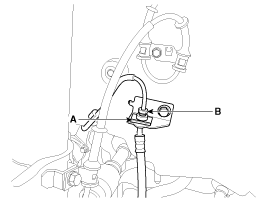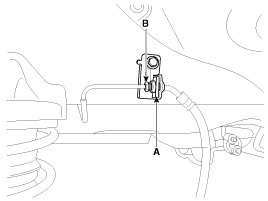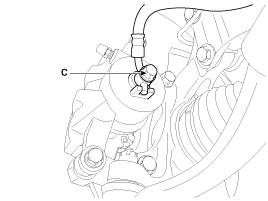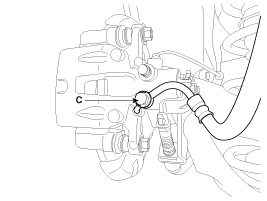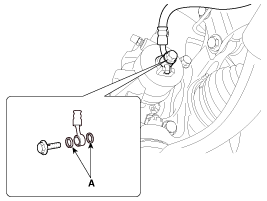 Hyundai Veloster: Brake Line. Repair procedures
Hyundai Veloster 2011-2017 Service Manual / Brake System / Brake System / Brake Line. Repair procedures
Hyundai Veloster: Brake Line. Repair procedures
Hyundai Veloster 2011-2017 Service Manual / Brake System / Brake System / Brake Line. Repair procedures
Hyundai Veloster 2011-2017 Service Manual / Brake System / Brake System / Brake Line. Repair procedures
Removal
| 1. |
Disconnect the brake fluid level switch connector, and remove
the reservoir cap.
|
| 2. |
Remove the brake fluid from the master cylinder reservoir with
a syringe.
|
| 3. |
Remove the wheel & tire.
|
| 4. |
Loosening the tube flare nut (B).
[Front]
[Rear]
|
| 5. |
Disconnect the brake tube by remove the brake hose clip (A).
|
| 6. |
Disconnect the brake hose from the brake caliper by loosening
the bolt (C).
[Front disc brake]
[Rear Disc brake]
|
Inspection
| 1. |
Check the brake tubes for cracks, crimps and corrosion.
|
| 2. |
Check the brake hoses for cracks, damage and fluid leakage.
|
| 3. |
Check the brake tube flare nuts for damage and fluid leakage.
|
| 4. |
Check brake hose mounting bracket for crack or deformation.
|
Installation
| 1. |
Installation is the reverse of removal.
|
| 2. |
After installation, bleed the
(Refer to Brake system bleeding)
|
| 3. |
Check the spilled brake oil.
|
 Brake Line. Components and Components Location
Brake Line. Components and Components Location
Components
...
 Brake Pedal. Components and Components Location
Brake Pedal. Components and Components Location
Components
1. Cowl bracket
2. Brake pedal member assembly
3. Stop lamp switch
4. Return spring
5. Brake pedal
6. Brake pedal pad
...
See also:
Tail Gate. Repair procedures
Replacement
Tail Gate Assembly Replacement
•
When removing and installing the tail gate,
...
Front Components and Components
Location
Components-1
1. Front bumper cover
2. Front bumper side bracket [LH]
3. Front bumper side bracket [RH]
Components-2 (T-GDI)
1. Front b ...
Heated Oxygen Sensor (HO2S). Troubleshooting
Signal Waveform
...
Categories
- Hyundai Veloster Manuals Home
- Hyundai Veloster 2010-2017 Owner's Manual
- Hyundai Veloster 2010-2017 Service Manual
В© 2011-2025 Copyright www.hvmanual.com

